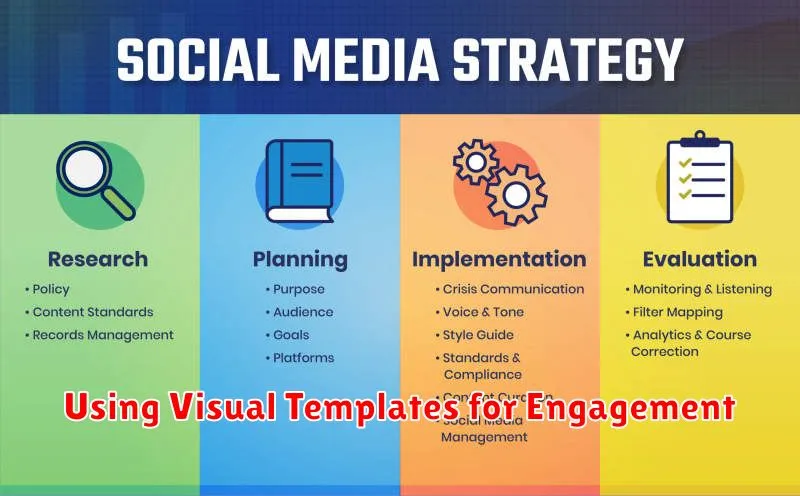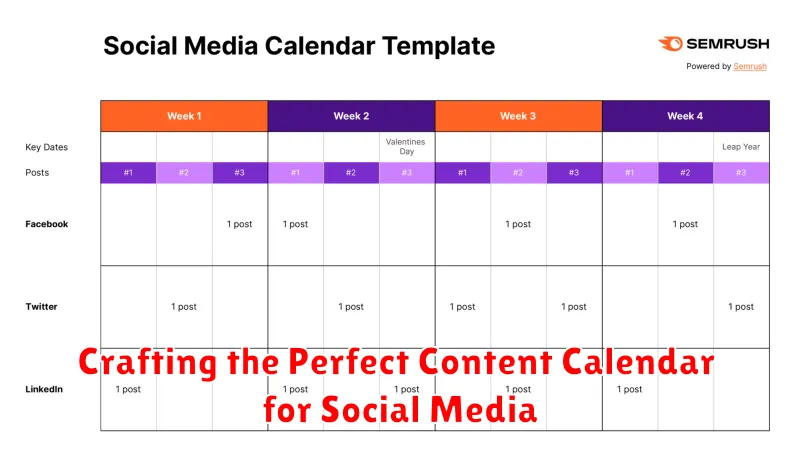In today’s digital landscape, a robust and well-planned social media presence is crucial for any business or individual seeking to connect with their target audience. A content calendar serves as the backbone of this presence, providing a strategic roadmap for your social media activities. This comprehensive guide will equip you with the knowledge and tools to craft the perfect content calendar, enabling you to maximize engagement, boost brand visibility, and ultimately achieve your social media marketing goals. Learn how to strategically plan your content, schedule posts effectively, and analyze performance to continuously refine your social media strategy.
Crafting the perfect content calendar involves more than just listing post ideas. It requires a deep understanding of your target audience, your brand voice, and the nuances of each social media platform. This article will delve into the essential elements of a successful content calendar, including topic ideation, content formatting, scheduling best practices, and performance analysis. By implementing the strategies outlined in this guide, you will be well on your way to creating a content calendar that drives meaningful results and elevates your social media presence.
Choosing the Right Platforms
Selecting the right social media platforms is crucial for maximizing your content calendar’s effectiveness. Don’t spread your resources thin. Instead, focus on the platforms where your target audience spends their time.
Consider your business goals. Are you aiming for brand awareness, lead generation, or driving sales? Different platforms cater to different objectives. For example, visually-driven platforms like Instagram are excellent for brand building, while LinkedIn is better suited for professional networking and lead generation.
Research your competitors. Identify the platforms they utilize and analyze their success. This can provide valuable insights into which platforms might be most effective for your industry.
Analyze your resources. Managing multiple social media platforms requires time, effort, and often budget. Choose platforms you can realistically maintain with consistent, high-quality content.
Setting Monthly Content Themes
Establishing monthly content themes provides a framework for your social media calendar. This helps maintain consistency and creates a more cohesive experience for your audience. Instead of randomly posting content, themes offer a strategic direction.
Consider your overall marketing goals and target audience when selecting themes. For example, if you’re a fitness brand, you might choose themes like “Summer Fitness Challenges,” “Nutrition Tips for Beginners,” or “Mindfulness and Meditation.” These themes should align with your brand’s values and resonate with your audience’s interests.
By focusing on specific themes each month, you can create targeted campaigns that generate more engagement and drive meaningful results.
Scheduling in Advance

A key advantage of a content calendar is the ability to schedule posts in advance. This saves time and ensures consistent posting, even during busy periods.
Utilize scheduling tools offered by various social media platforms or dedicated social media management software. These tools allow you to prepare content, select posting times, and automate the publishing process.
Plan your content strategically, considering optimal posting times for your target audience. Analyze your past performance data to identify when your audience is most active.
While scheduling in advance offers significant benefits, remember to remain flexible. Be prepared to adjust your schedule to accommodate breaking news, trending topics, or important events.
Balancing Promotional and Informational Content
A successful social media presence requires a delicate balance between promotional and informational content. Too much promotion can feel spammy and drive followers away, while solely informational content may not effectively achieve your marketing goals. Finding the right ratio is key to engaging your audience and driving conversions.
Informational content builds trust and establishes your brand as a valuable resource. This type of content can include industry news, tips and tricks, behind-the-scenes glimpses, and answers to frequently asked questions. It provides value to your followers without explicitly pushing a product or service.
Promotional content, on the other hand, focuses on advertising your products or services. This can include announcements of sales, new product releases, customer testimonials, and calls to action. Effective promotional content highlights the benefits of your offerings and encourages engagement.
A common recommendation is to follow the 80/20 rule: 80% informational content and 20% promotional content. However, the optimal balance will depend on your specific audience, industry, and goals. Experiment and analyze your results to determine what resonates best with your followers.
Using Visual Templates for Engagement

Visual consistency is key to a recognizable and engaging social media presence. Utilizing visual templates can streamline your content creation process while maintaining a cohesive brand aesthetic.
Templates can be used for various content formats, including quotes, promotional graphics, and even simple informational posts. Pre-designed templates ensure your branding elements, such as logos, color palettes, and fonts, are consistently applied across all platforms.
Consider creating a few template variations for different types of content. This allows for flexibility while maintaining a consistent visual identity. Templates save you time and effort, freeing you to focus on crafting compelling copy and engaging with your audience.
Analyzing Performance Metrics
Analyzing performance metrics is crucial for optimizing your social media content calendar. It provides valuable insights into what resonates with your audience and what needs improvement.
Key metrics to track include:
- Reach: How many unique users saw your content.
- Engagement: Likes, comments, shares, and saves indicate audience interaction.
- Impressions: The total number of times your content was displayed.
- Website Clicks: How often users clicked links leading to your website.
- Conversion Rate: The percentage of users who completed a desired action (e.g., purchase, sign-up).
Regularly review these metrics to understand trends and patterns. This data-driven approach allows you to refine your content strategy, improve engagement, and ultimately achieve your social media objectives.
Updating Based on Real-Time Trends
While a content calendar provides structure, it shouldn’t be rigid. Real-time trends offer valuable opportunities to connect with your audience on current events and popular discussions.
Monitor trending hashtags and topics relevant to your industry. Be prepared to adapt your planned content to incorporate these trends organically. This demonstrates that your brand is engaged and responsive.
Flexibility is key. Consider setting aside buffer time in your calendar to accommodate real-time content. This could involve rescheduling less time-sensitive posts or creating quick, reactive content.
However, exercise discretion. Not every trend is suitable for your brand. Ensure that any real-time content aligns with your brand values and messaging. Jumping on an irrelevant trend can appear forced or even damaging.

